The Aloe Vera plant generally has a lifespan of 12-14 years. They are easy to care for and can thrive in neglect. But, continuous negligence can result in death even before its lifespan ends. You must find the reasons behind it and try to revive them back.
Aloe Vera dies due to poor watering habits, inadequate light, poor drainage, lack of nutrition, and cold damage. To revive a dying aloe vera plant, trim off the damaged parts, repot if required, maintain ideal requirements, and don’t stress them further with any unfavorable conditions.
Both beginners and experienced gardeners will have this problem at some point. Today, I will explain the reasons behind a dying Aloe Vera plant and how to revive it. So, let’s start without further delay.
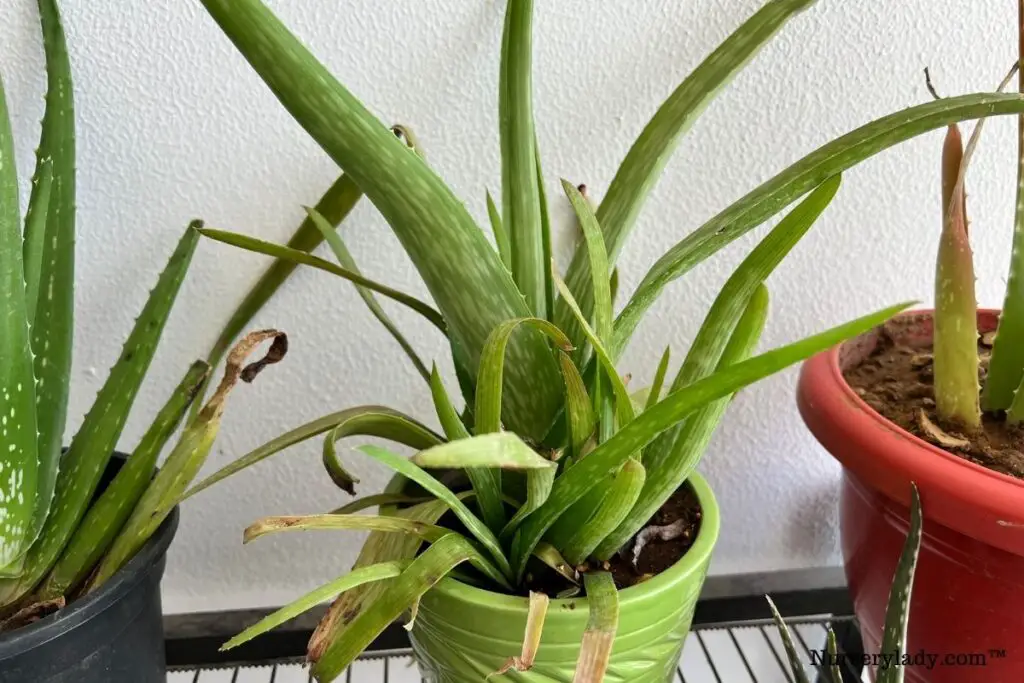
My Aloe Vera is dying – what should I know?
Aloes thrive in dry areas with sandy soil, bright sun, and infrequent rainfall.
They are effortless to grow and are available in many varieties.
With proper care and maintenance, they will grow both indoors and outdoors.
Aloes are hard to kill due to their endurance for dry conditions, sunlight, and warm temperature.
With 4-6 hours of sunlight, scarce watering, warm temperature, and low humidity, they can flourish easily.
But, overwatering them, not giving them enough sunlight, exposing them to high humidity and cold temperatures, and using ordinary soil can deteriorate the health of Aloes and even kill them.
When such conditions remain in or around the plant for a long time, the plant starts to die.
It will also show specific signs indicating that they are dying.
By identifying the signs and taking appropriate action, you can revive your plant back.
Signs of a dying Aloe Vera:
- Discolored leaves
- Soft and mushy leaves
- Plant rotting at the base
- Black spots all over
- Dry and crispy leaves with discolored edges
- Drooping plant and dead leaves at the base
Why is my Aloe Vera dying, and how to revive it?
Aloe Vera will die due to critical situations like overwatering, root rot, poor drainage, lack of light, exposure to harsh sunlight and cold temperature, etc.
Sometimes, death is natural when they finish their lifespan.
Here are 11 steps to revive a dying Aloe Vera plant:
1. Stop watering if the plant is overwatered.
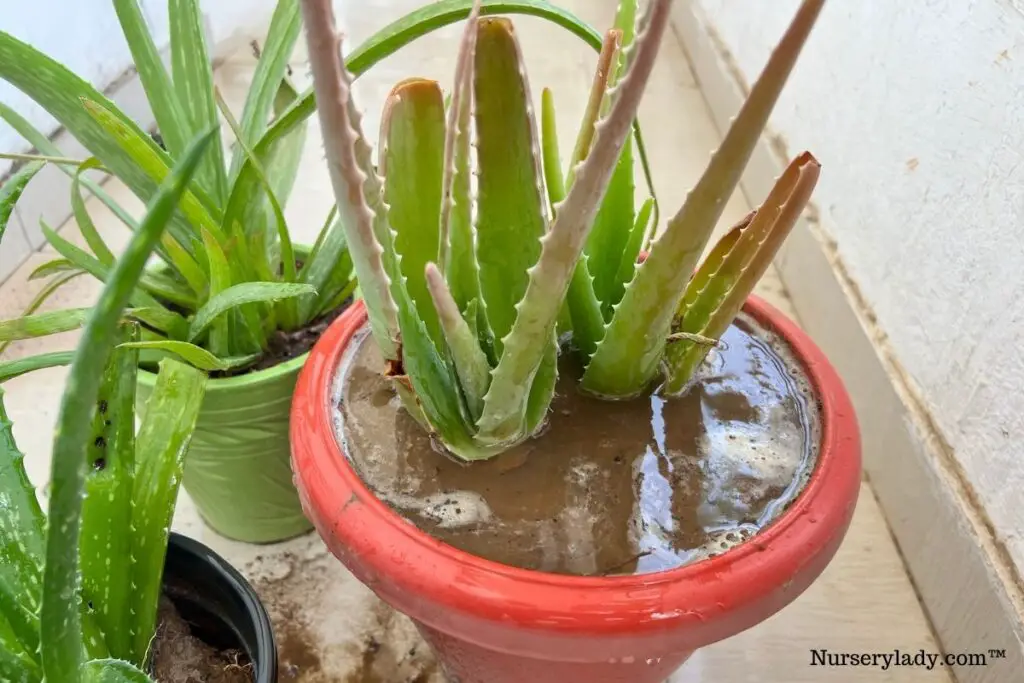
Aloe Veras enjoy dry conditions.
They can even stay without water for some days as they store water in their leaves.
So they don’t require frequent watering.
If you constantly water them without letting the soil dry, the plant will absorb excess moisture and get overwatered.
Moreover, overwatering Aloes for extended periods will also lead to root rot, and your plant may die if the situation worsens.
This occurs mainly with the potted plants because:
- We cannot see or feel the soil downwards.
- The pot sometimes doesn’t have drainage holes, due to which even right watering will lead to overwatering.
- If your plant is indoors, it won’t get enough light as outdoor plants.
To revive the plant from overwatering:
- If the plant has mild overwatering signs, stop watering for some time until the soil dries.
- Let them have bright but indirect sunlight. Direct sunlight will stress your Aloe veras. But providing sufficient indirect sunlight will help the soil dry faster.
- Use gritty ingredients like coarse sand, perlite, or gravel to improve the drainage.
- Allow the soil to dry out between each watering. At least 3/4th portion of the soil around the roots should be dry. Water them only when 2-3 inches of the topsoil is dry.
- If you must follow a routine, water them once every 2-3 weeks.
- Watering will depend on the weather. Aloes need less water during the winters and during summer dormancy when the temperature rises above 80-90°F.
Also read: How Do You Revive An Overwatered Aloe Plant? (Complete Guide)
Looking for gardening supplies? We have tested 100's of products before recommending them to you guys. Check out our best pick below:
| Image | Gardening Supplies | Best Price? |
|---|---|---|
 Top
Top Top
Top | Raised Garden Bed Kit | Check On Amazon |
 | XLUX Soil Moisture Meter, Plant Water Monitor, Soil Hygrometer Sensor for Gardening, Farming, Indoor and Outdoor Plants, No Batteries Required | No Results |
 Top
Top Top
Top | 82 Pcs Garden Tools Set and Extra Succulent Tools Set | Check On Amazon |
 | Joeys Garden Expandable Garden Hose with 8 Function Hose Nozzle, Lightweight Anti-Kink Flexible Garden Hoses, Extra Strength Fabric with Double Latex Core, (50 FT, Black) | No Results |
 Top
Top Top
Top | Dual Chamber Compost Tumbler | Check On Amazon |
 Top
Top Top
Top | Sunnyglade Plant Stakes | Check On Amazon |
 Top
Top Top
Top | Organic Cold Pressed Neem Seed Oil | Check On Amazon |
 Top
Top Top
Top | Mighty Mint Gallon :-Insect and Pest Control Peppermint Oil | Check On Amazon |
 Top
Top Top
Top | Scotts DiseaseEx Lawn Fungicide | Check On Amazon |
 Top
Top Top
Top | Jacks Classic 20-20-20 All Purpose Fertilizer | Check On Amazon |
 Top
Top Top
Top | 30,000 Seeds Pollinator Attracting Wildflower Mixture | Check On Amazon |
 Top
Top Top
Top | Survival Vegetable Seeds Garden Kit-Over 16,000 Seeds | Check On Amazon |
2. Repot if the plant shows dying signs from root rot
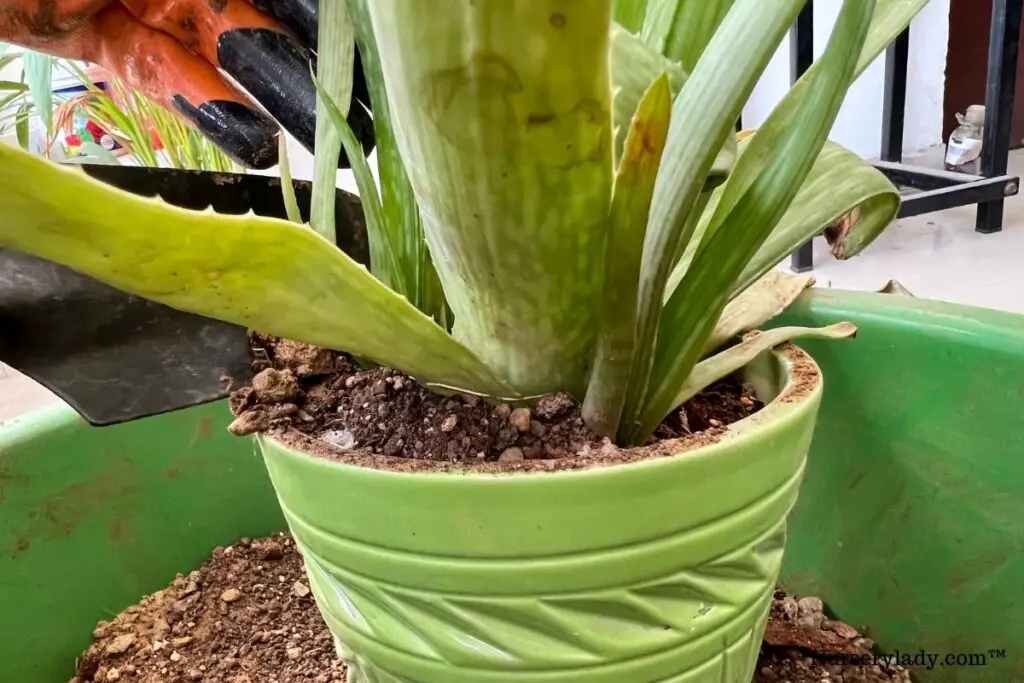
Due to the same reasons, the plant will suffer root rot.
To save the plant from root rot, you have to repot the plant urgently.
Here is a step-by-step guide to repotting:
- Take the plant out of the container and remove the soil from the roots.
- Remove the dark and mushy roots. You might have to remove all the roots if they are damaged.
- Now, prepare a new container and new soil. Though you can use the old container by cleaning it with bleaching powder and soap water, it is always better to use a new one. The soil mix must be new.
- Fill half of the container with the new soil, place the plant, and cover the base with the remaining soil.
- Water the plant after a few days and don’t expose them to direct sunlight.
Also read: How To Repot An Aloe Vera Plant? (Step-by-Step Guide)
3. Examine the Aloe leaves to check if they are underwatered
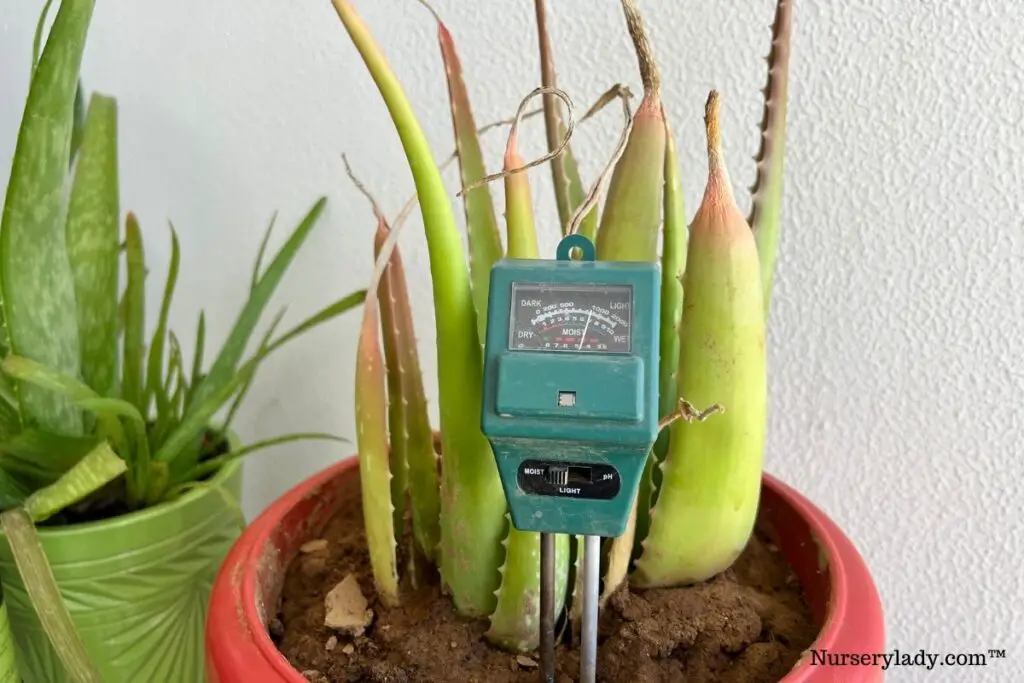
Belonging to the succulent category, Aloe Veras store water in their leaves as a strategy to survive dry weather and high temperatures.
But, if it doesn’t receive enough water, the leaves will become droopy and transparent.
However, looks can be deceiving.
It could also be a sign of overwatering or root rot.
Due to suffocation from excess water, the roots fail to pass the water to other parts.
Eventually, the plant looks dehydrated.
The difference lies in the texture.
In overwatering, the leaves will feel mushy, whereas they will feel dry and brittle in underwatering.
To revive the plant from prolonged dehydration:
- Give your plant a good drink. But don’t create a pool around them.
- Water them enough until the water drains out of the drainage holes.
- If it’s in the ground, soak the soil very well.
- But, if it’s showing signs of underwatering despite current watering, check the soil. Go through the overwatering and root rot point discussed previously.
Also read: How To Water Aloe Vera Plant? (How often, Summer, Winter)
4. Move the Aloe Vera to shade or partial shade if it looks sunburned.
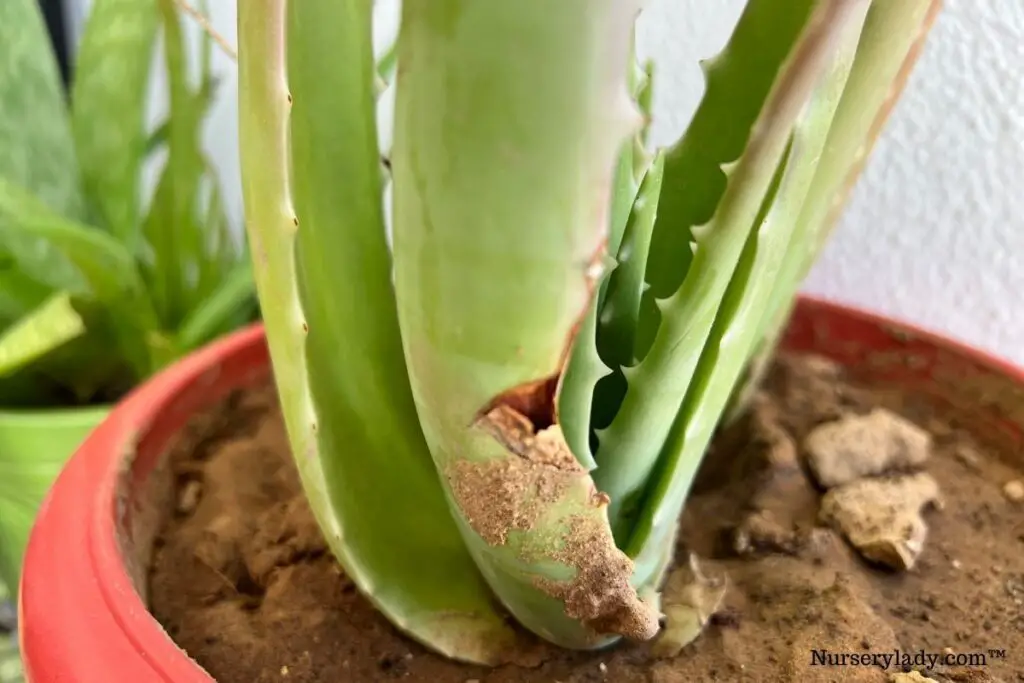
Aloe Vera grows well when they receive sufficient sunlight.
But exposure to harsh sunlight will lead to sunburn.
Moreover, the water stored in the leaves will also heat up, increase the risk of burns and make the leaves squishy.
Yellow leaves or brown patches on the foliage and mushy leaves are signs of sunburns.
If the problem prolongs, the plant will die.
To revive a dying Aloe Vera plant:
- Fix shading nets over the soil bed if your plant is in the ground.
- Shift your potted Aloe to a partially shady area
- Shift your indoor Aloe a few feet back from the window and fix transparent curtains to filter the light
- Keep your plant near the north or east-facing window as this direction gives less intense sunlight.
Also read: Aloe Vera Temperature Tolerance: Ideal Temperature+Keeping Them Safe
5. Expose the Aloes to more sunlight if they are not getting enough
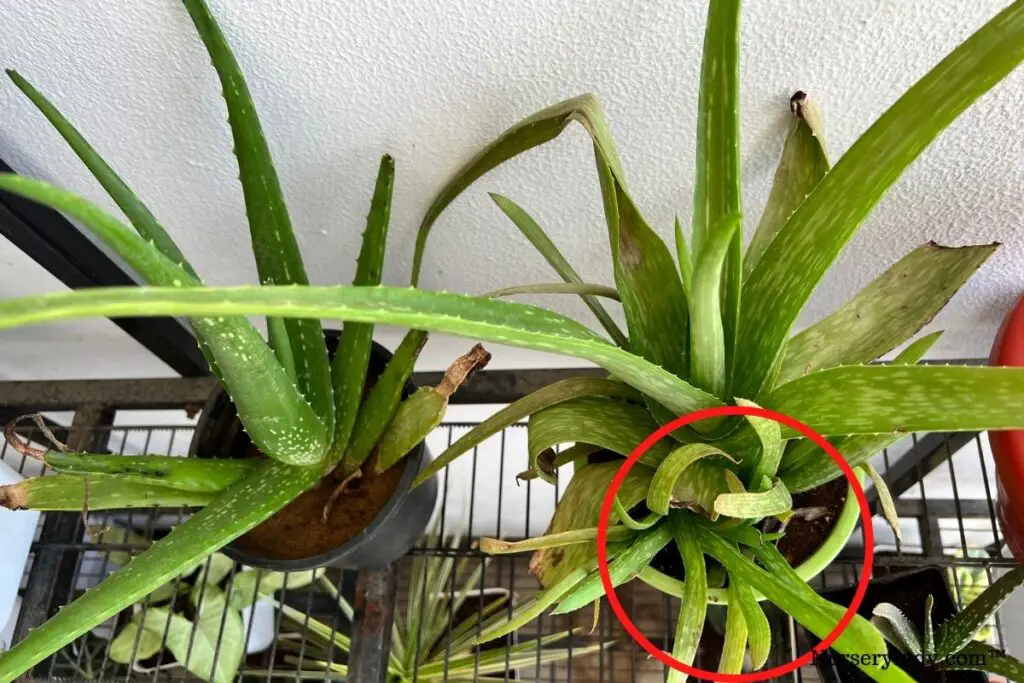
Growing Aloe Vera indoors may give your interior space a good look, but they won’t receive enough sunlight as they do outdoors.
Since Aloes thrive in desert areas under the sun, sunlight penetrating from the window won’t be enough for them.
If your outdoor plant stays in a damp spot for a long time, the leaves will lose their color, the plant will be small, and the soil won’t dry out quickly.
It also creates an obstacle in producing chlorophyll and functioning photosynthesis. If the situation continues, the plant can end up dying.
To save the plant from dying due to lack of light:
- Shift your plant to a bright spot. Since the plant has been under shade for so long, don’t expose them to direct sun straightaway. First, let it stay under filtered light for some days, then partial sun for some more days, and then under the direct sun for 2-3 hours only. Over time, increase the timing.
- If your plant is indoors, shift them near a sunny spot and maintain acclimatization.
- A south or west-facing window gives too much sunlight, so don’t put the plant near this window during summers. Keep the plant in this direction in winters since the sun level is low.
- For summers, try the north or east-facing windows.
Also read: What Kind Of Light For Aloe Vera Plants? (Full sun, Shade, Or Partial Light?)
6. Replace the soil if it is not draining well and lacks nutrients
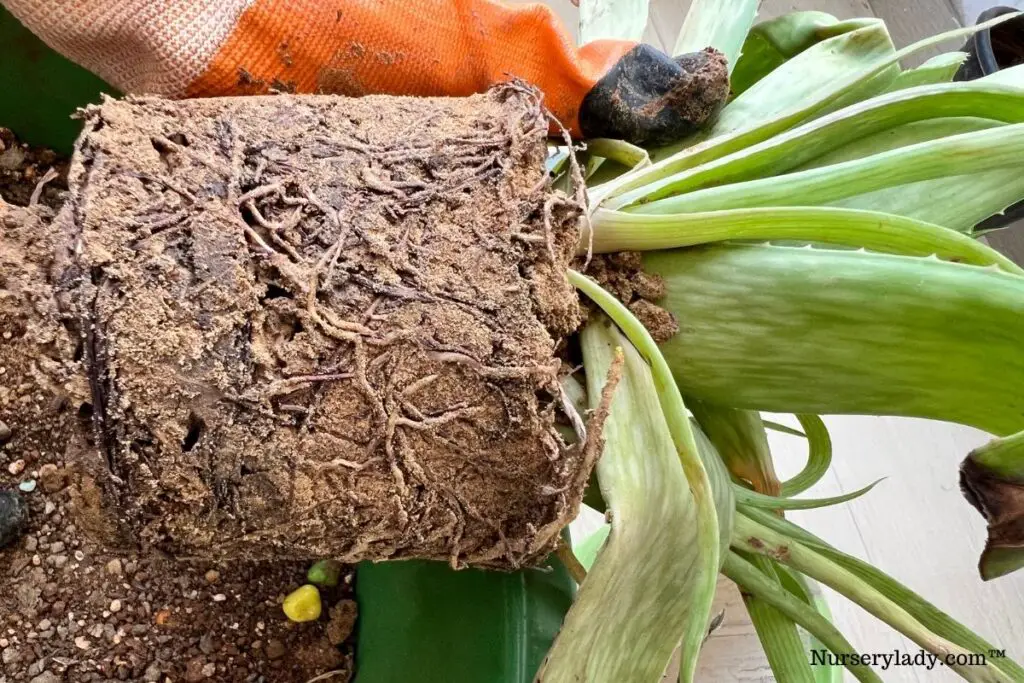
Generally, the Aloes don’t require highly nutritious soil.
They can easily thrive in poor soil. But lack of some nutrients can make your plant die.
Due to this deficiency, the plant will become pale.
Over time, the leaves will wither, and the plant will die.
Similarly, soil drainage is essential.
Since they naturally grow over sandy soil that doesn’t hold moisture, you must mimic the same growing medium.
If the soil fails in drainage, the roots will remain wet and result in root rot.
This will, in turn, kill the plant.
To revive the plant from such conditions, you should replace the soil.
If the problem is only drainage, add perlite, coarse sand, and gravel to improve the drainage.
If the problem is nutrition, you might have to change the soil.
Also read: What Type Of Soil For Aloe Vera Plant? (+Ideal Soil Mix)
7. Drainage holes are important for the potted Aloe Veras
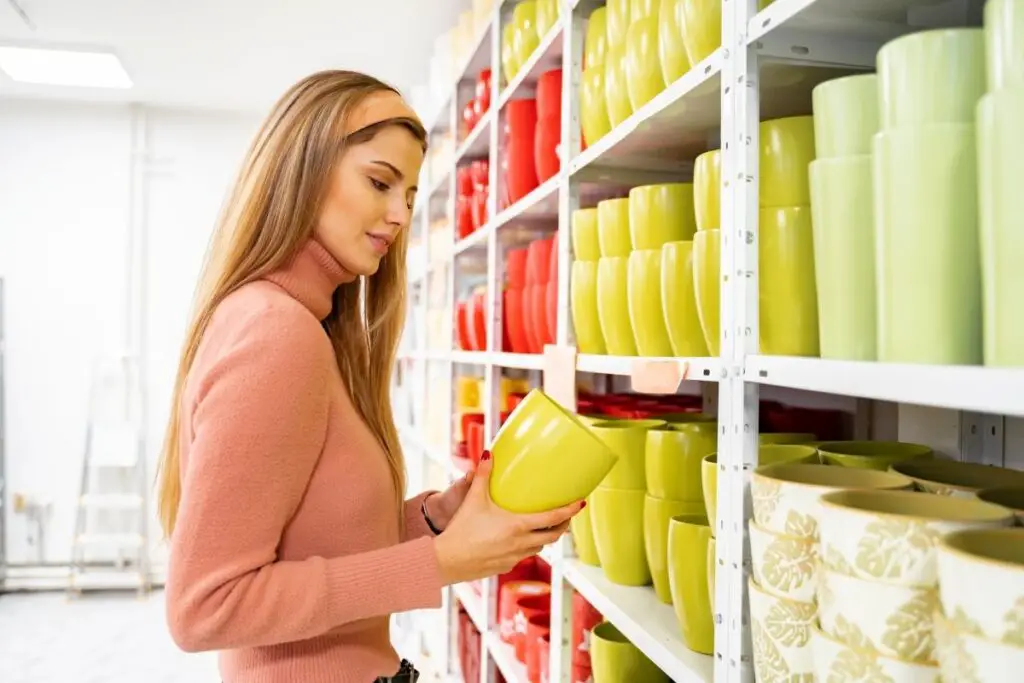
If you are growing them in pots, there must be drainage holes.
It will help the soil drain the excess water between the watering.
A container with no drainage holes will keep the water stagnant in the soil.
As a result, the soil around the roots will remain wet and begin to rot over time.
Ultimately, the plant will die.
Besides drainage, also ensure the size.
Both under-sized and oversized containers will cause problems.
The former will make the roots outgrow the drainage holes, compact, and hold moisture, thus resulting in overwatering.
An oversized container requires a lot of soil which will take forever to dry.
This, too, will keep the soil around the roots wet for a long time and cause roots to rot.
To revive a dying Aloe Vera plant due to the wrong type of container:
- Immediately change the container
- While selecting a pot, ensuring its drainage system is your first job.
- Select a container that depends on the size of the plant. It should be 1/3rd bigger than the plant’s root system.
- To aid in the draining process, use terracotta pots. As it is made of porous materials, it won’t hold moisture.
Also read: What Pot Is Best For Aloe Vera Plant? (Pot Type, Size & More)
8. You must protect the Aloe Veras from the cold temperatures
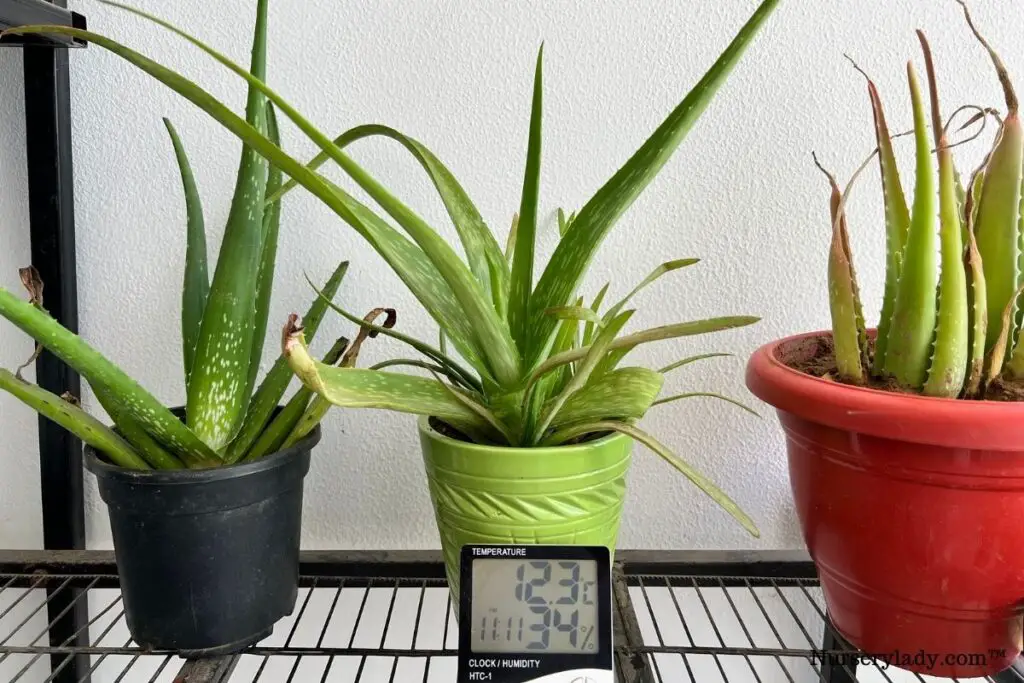
Belonging to the warm, arid regions, Aloes are sensitive to cold temperatures.
They will get frost and freeze damage.
Though the former is less risky, freeze damage will kill the plant.
However, there are still chances of revival if you take quick action.
Below are some steps:
- Bring your plant indoors immediately if they are outside in the frosty weather.
- Maintain a warm temperature near them, at least around 60-75°F. But don’t put them close to heaters, radiators, or ovens. A warm room with an ideal temperature would work.
- If only a few leaves have turned brown, let the plant dry out, and then you can remove them from the plant. It will encourage new leaf growth.
- When your plant is in such crisis, you must scale back watering, especially for the outside Aloes.
- To prevent such damages, let them have enough sunlight throughout the day and give them protection after the sunsets.
- You can bring them indoors. You can also fix frost clothes.
- If your Aloe is an indoor plant, keep them near the south or west-facing window for enough sun.
- Use well-drained soil to help them dry faster. You cannot completely neglect water because hydration is important. Using well-drained soil helps in increasing the drying and draining process.
- If your area receives frost, you should grow Aloes in containers for bringing them indoors in winters.
- Cover the soil surface with small pebbles or stones. It doesn’t let the moisture evaporate faster, so you can skip watering for weeks. Additionally, it traps the warmth in the roots and even prevents the cold from reaching and shocking the roots.
Also read: Can Aloe Vera Plants Survive Cold Weather? (+Deal With Cold Damage)
9. Check for pests and diseases.
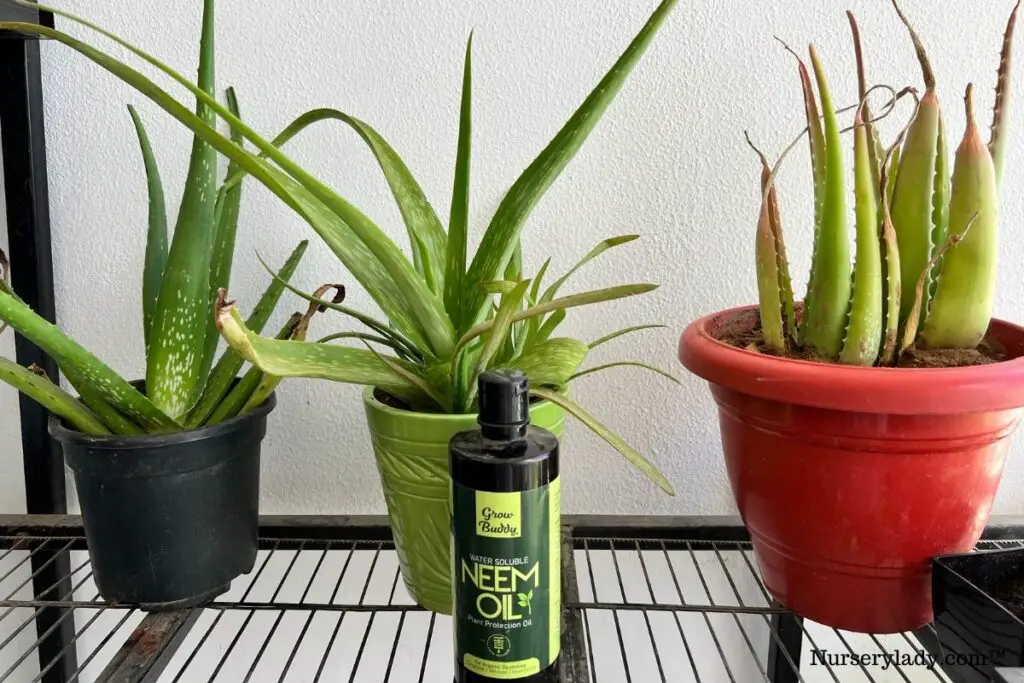
Prolonged damp and dry conditions combined with a hot or cold climate can result in infestations. Pests like aphids, mealybugs, aloe mites, and spider mites enjoy staying in extremely dry or wet conditions.
They suck the saps of the plant and make the plant discolored, pale, weak, lifeless, and prone to diseases.
Aloe mites cause cancerous growth and kill the plant.
Diseases like Aloe Rust, Bacterial Soft Rot, Leaf Spot Disease, Anthracnose, Base Rot disease, and Basal Stem Rot are fungal diseases in the Aloes.
If ignored, the plant will die eventually.
Infestation is not the end of the plant unless and until the damage level has crossed 50%.
You can always bring the plant back with the right and immediate steps.
To save a dying plant from pest infestation:
- Spray neem oil to the infected area to kill them.
- Dab rubbing alcohol to the infected area to weaken the hard-shelled pests and kill them.
- For treating pests that love wet conditions, stop watering and expose them to bright filtered sunlight. Once the soil dries, it will leave your plant.
- For removing the pests that love dry conditions, shower the plant well to remove them from the plant.
- Use insecticidal soaps and pesticides to treat them if the infestation is too much.
- You can also release ladybugs and mantis for letting them feed on the soft-bodied bugs.
To get rid of diseases:
- Isolate the plant to prevent spreading.
- Remove the damaged parts of the plant and discard them in the dustbin. Never throw them near your garden or use them as compost.
- Use fungicides to eliminate the spores and prevent the fungi from further occurrence.
- If the disease is at its initial stage, neem oil can help eliminate it in the beginning.
- You will also have to repot the plant with new soil and container as the old ones got contaminated.
- You can also use homemade fungicides like copper-based fungicides or the ones made with baking soda.
- Maintain low humidity around the Aloes and don’t bother them much with watering or direct sunlight until the problem resolves.
- Avoid splashing water on the leaves while watering as it can increase the humidity and make the plant prone to diseases.
Also read: Why Does My Aloe Vera Plant Have Bugs (+How To Eliminate)
10. Remove the dead leaves from the plant.
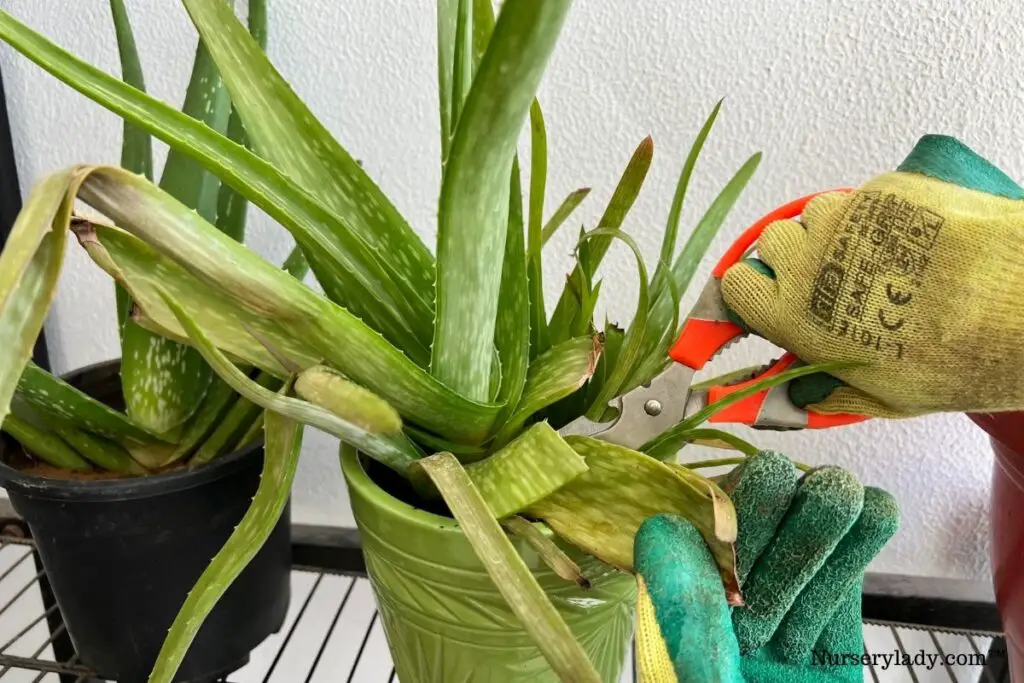
You should remove the dead and damaged leaves from the plants on time.
These leaves pull lots of nutrients from the soil and the other healthy parts of the plant.
Moreover, these leaves can infect the other good leaves and slowly kill them.
Letting the dead leaves stay can also invite pests and fungus.
To save the plant from such conditions:
- Remove the dead and damaged leaves from the plant. It encourages more leaf growth in the plant and fast recovery.
- But don’t cut off the broken leaves. Let the cut part seal and heal. Over time, it will turn brown. Remove it at that time.
Also read: How To Trim Aloe Vera Plant? (Step-by-Step Guide)
11. Cut off the healthy leaves for propagation if it’s impossible to save the plant.
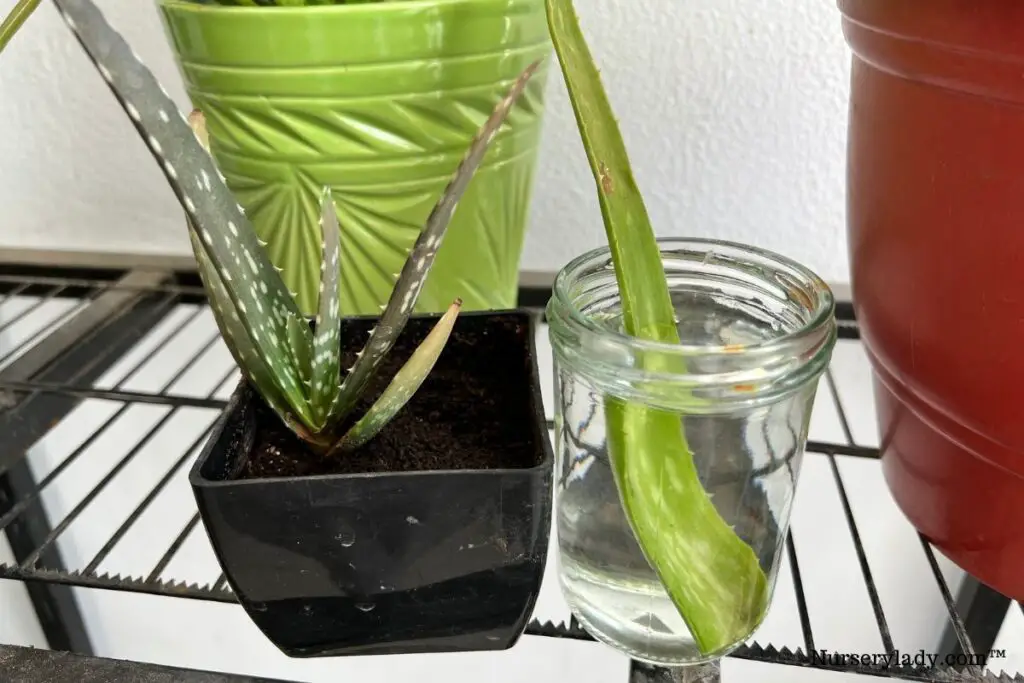
Sometimes, the health of the Aloes deteriorates so much that reviving the whole plant becomes impossible.
But, you can revive the Aloe Vera by propagation with leaves or pups.
- Find out for the pups at the base of the plant. Separate them and plant them in a container with new, well-drained soil. Don’t expose them to sunlight for a few weeks until their establishment. Water them after a few days, but sparingly until they have settled.
- If there are no pups, search for healthy leaves. Trim them off for propagation. There might not be very high chances of successful propagation, but there is no problem trying. After all, hope is everything.
- Cut the leaves close to the stem and let the leaves heal for a few days. After some days, when you find the cut portion has hardened, plant them in well-drained soil. Water the soil by misting because this won’t let the soil get wet too much. Keep them under bright indirect light. You will find new roots after a few weeks.
- Propagating might be the only way left to save your Aloe Vera plant. So, try everything and give your best to get it back.
Also read: How To Propagate Aloe Vera Plant? (Step-by-Step Guide)
Final thoughts
Understanding the steps to revive a dying Aloe Vera plant is easy if you know the problems, their identification, and ways to solve them. You can easily save the plant with a little bit of effort.
Aloe Veras are easy to take care of as they thrive in neglect. But you must give attention to a few things and avoid situations that can kill the plant.
But don’t panic if your plant is impossible to save. You can still get your Aloe Vera back through propagation. Find out the pups or healthy leaves and propagate them properly to get a new Aloe Vera.
Aloes survive for 10-12 years. So, they will die once their lifespan is over. There is nothing to do for revival. But, you will get new Aloes through propagation.
Reference: NCBI, New York Botanical Garden, University of New Hampshire, University of Florida, Wikipedia.
